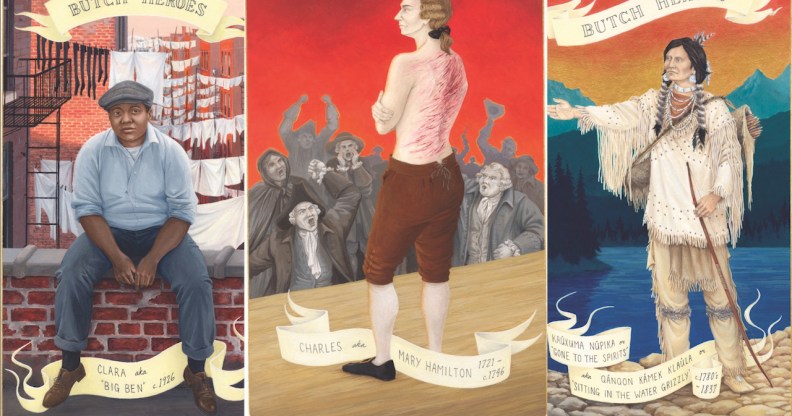Butch Heroes illustrations show the power of butch in history

Butch Heroes (Ria Brodell)
We all know the amazing power of butch, an identity that has been around a long time—and now these illustrations are proving just that.
A new series, Butch Heroes, created by queer illustrator Ria Brodell, demonstrates how powerful and varied butch identity can be—and has been throughout history.
From Eleno de Céspedes, the first known woman surgeon in Europe, New York’s 1920’s black lesbian circle, the illustrations celebrate heroic but forgotten butch figures from the fifteenth to twentieth century and now form a book, Butch Heroes.
The illustrated series began when Brodell “had been musing about what my life would have been like as a queer person had I been born into another era.”
“I had just completed a set of self-portraits, one of which was Self-Portrait as a Nun or Monk, circa 1250—I wanted to know how we lived, so I started looking,” they explained.
The butch heroes illustrated are individuals who were assigned female at birth but whose gender presentation was more masculine than feminine, who said no to heterosexual marriage, and who often faced dire punishment for being themselves.
What does it mean to be butch?
“One reason I chose the term butch is because it’s recognisable both within, and outside of the LGBTQIA community,” Brodell told PinkNews.
“I have a complicated relationship with the term butch. For me, it was often used in a derogatory way. However, it’s also used as a congratulatory recognition of strength. I like that dual nature.
“I ultimately chose it because of it’s familiarity and because it’s a concise term that means strong, brave and masculine. And, I thought Butch Heroes had a nice ring to it.

Clara aka “Big Ben” was well known in New York lesbian circles in the 1920’s (Ria Brodell)
“Right now I’m using non-binary trans to refer to myself. Like the term butch, I’ve had a complicated relationship with LGBTQIA terms. Over the years I’ve used gay, dyke, butch, transgender, genderqueer, or queer. I find terminology exciting in its evolution but also frustrating in its limitations.
“However, I’ve found it helpful in seeking out a community. This is the reason I never use contemporary terminology when referring to the subjects of my Butch Heroes series, first because none of these terms existed during their lifetimes, but primarily because I know the difficulty of finding terms that feel like they fit.

Carl Lapp, a Sami, was refused burial by the Swedish church for having a “female body” (Ria Brodell)
“I have no way of knowing how my subjects would have self-identified given today’s options. Instead, I have to use their actions, their gender presentation and sometimes their own voice to determine the pronouns I use to refer to them, how I depict them, or whether they fit into the series at all.”
How did you pick which butch heroes to illustrate?
“I started by going to the LGBTQIA sections of local libraries and scanning through the books on our history for chapters, or in some cases a paragraph or even just a sentence on the information I was looking for.
“And that criteria is very specific: names and information on people who were assigned female at birth, had documented relationships with women, and whose gender presentation was more masculine than feminine.

Charles Hamilton, formerly Mary, was put on trial for marrying a woman (Ria Brodell)
“I also would look through bibliographies for more sources, or search through journal and newspaper databases. Finding the names of actual individuals, as opposed to just generalised stories or legends, is the most difficult part.
“Sometimes there are only fragments of stories, or sometimes really great stories but no name was recorded. That’s really frustrating. At this point my search is more tailored as I look for people from specific regions of the world.”
What can we learn from our butch heroes?
“I’ve learned so much. Sometimes fun or funny stuff, like the innumerable euphemisms for strap-ons, genitalia or same-sex relations, but I think the most striking for me is learning about cultures in which there was no binary.
“History is full of multiple expressions of gender and sexuality. That is exciting. That knowledge has helped me as an individual feel validated, to be who I am and identify however I choose.

According to Eleno’s testimony before the Spanish Inquisition in 1587, while giving birth to her son, she grew a penis (Ria Brodell)
“I think the knowledge that, despite opposition, in one way or another queer people made lives for themselves in every corner of the world, in every time period is powerful.
“This is nothing new. We have always been here, we belong here and have a right to be here in all of our forms.

Okuhara Seiko adopted a gender-neutral name and also set up a school for girls in Japan (Ria Brodell)
“My hope is that this history helps others on an individual level, but also demonstrates that at a larger societal level our relationship with sexuality, and especially gender, could be so much more expansive than the binaries that are so prevalent today.”
Butch Heroes is available to buy as a book from The MIT Press here.

